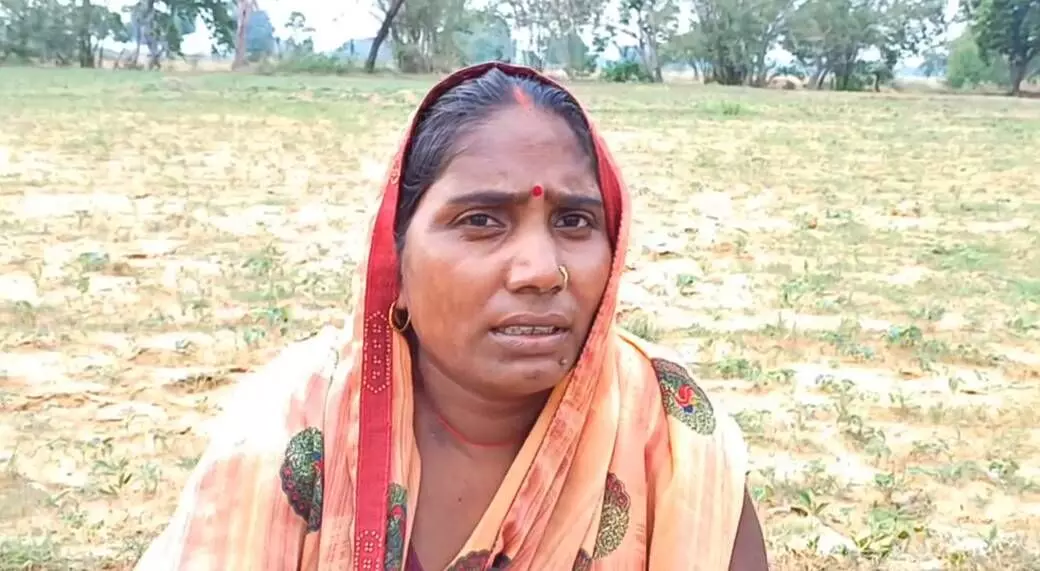Handora, Mirzapur (Uttar Pradesh)
Asharam Yadav is distressed. The 35-year-old dairy farmer from Handora village in Uttar Pradesh’s Mirzapur is not sure how he is going to save the life of the three buffaloes he owns. The milk from these buffaloes is his only source of income.
“It has barely rained in Mirzapur this year, and my buffaloes need at least 50-70 litres of water a day to survive the heat. All the ponds in my village have dried up and I now depend on a single hand pump in my house,” Yadav told Gaon Connection.
According to the India Meteorological Department [IMD] rainfall report on August 1, Mirzapur is amongst the three districts in the state which has recorded the highest deficit rainfall this monsoon. The district has recorded ‘large deficient’ rainfall of minus 69 per cent. Only Mau district with minus 72 per cent rainfall is faring worse than Mirzapur in the state.
Also Read: The man who owns 435,000 sq ft of land may not have rice to eat this year

Asharam Yadav said that he had never witnessed such parched conditions in his village.
Also, as per the National Dairy Development Board, buffaloes, which are Yadav’s most prized asset, require a daily intake of 100 litres of water to survive in the summer months.
“The Bansagar canal’s water isn’t very far from my house and my buffaloes used to bathe there and also drink water from the canal but it has been dry for weeks now. I also own five bighas [almost an hectare] of land which I would have sown paddy on. There are 12 people in my family and the land used to produce enough paddy for us to eat for the entire year but it is all barren this year,” Yadav said.
“The price of fodder is increasing every day and soon my buffaloes will have neither food nor water to drink,” Yadav lamented.
“The fodder costs me Rs 1,400 per quintal. It barely lasts a week. A buffalo needs almost five kilogrammes of fodder daily but I am feeding them barely a kilogramme each. The lack of rainfall has dried up all grasslands,” he said.
At least Yadav has a handpump at home that gives some water. Sunita Kumari Yadav’s neighbour is not so lucky.

“I have to use another hand pump which is about half a kilometres away. My arms hurt all the time. I carry almost 20 buckets of water to my house every day,” Kumari told Gaon Connection.
According to her, no farmer in the village has sowed paddy yet. “I own almost 10 bigha [two hectares] of land but it is of no use sowing anything right now. We are desperately waiting for the rains or the government to provide some respite from the shortage of water,” she said.
IMD data reported that at least 25 districts in the state are witnessing rainfall deficit between minus 50 to minus 20 per cent [deficient] while eight districts are exhibiting rainfall deficit of more than minus 60 per cent [large deficit].

Sunita Kumari
DM livid over unregulated release & diversion of canal water
Meanwhile, in a video that went viral on social media, Divya Mittal, the district magistrate of Mirzapur was seen reprimanding the officials of the Bansagar Canal Project for diverting the flow of water towards Prayagraj.
“On what basis was the water diverted towards Prayagraj when farmers in Mirzapur are complaining about their wilting crops. Why was the water released without the district magistrate’s approval,” she demanded to know.
Expenses on diesel soar as lack of rainfall makes farmers dependent on tubewells
Meanwhile, farmers from districts like Sitapur and Barabanki which are situated in central Uttar Pradesh have also complained about the insufficient rainfall raising their input costs.
“My paddy crop is wilting due to insufficient rainfall. The expenses on diesel and insecticides have increased . I am having to spray more insecticides because of the humid conditions and lack of rainfall. A single spray of insecticides costs me Rs 800,” Mohit Singh, a farmer from Paina Khurda village in Shahjahanpur district told Gaon Connection.

Also Read: Seeds of Sorrow: Farmers in Marathwada fear a harvest of losses this year
“If it doesn’t rain in a day or two, my hopes of getting profits from this crop will end,” the 21-year-old added.
Meanwhile, about 100 kilometres away from Sitapur, Hariom Awasthi, a paddy farmer from Umri village in Barabanki told Gaon Connection that irrigation can never make up for lack of rainfall.
“No matter how much I irrigate my fields, unless it rains, the yield will not be good. I am irrigating my field every fifth day now,” Awasthi said.
Vijay Kumar, the crop safety officer in the agriculture department in Barabanki told Gaon Connection that if the farmers don’t irrigate their fields properly then the insecticides and fertilisers will destroy the crop.
“The farmers have to regularly irrigate their crops. Otherwise they will suffer losses. Also, if they do not have enough water, they should not over fertilise, because that will be counter-productive,” Kumar said.
With inputs from Ramji Mishra in Sitapur and Virendra Singh in Barabanki




















